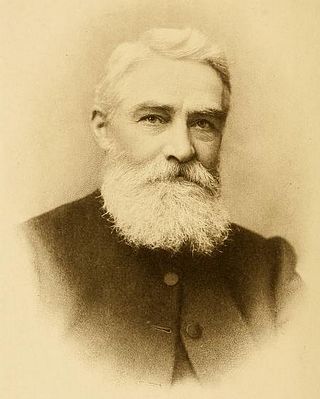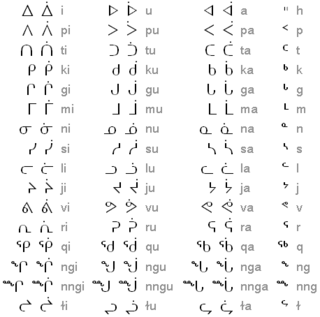Related Research Articles

The Inuit languages are a closely related group of indigenous American languages traditionally spoken across the North American Arctic and adjacent subarctic, reaching farthest south in Labrador. The related Yupik languages are the two main branches of Eskaleut, a primary language family. The Inuit live primarily in three countries: Greenland, Canada, and the United States.
A pidgin, or pidgin language, is a grammatically simplified means of communication that develops between two or more groups of people that do not have a language in common: typically, its vocabulary and grammar are limited and often drawn from several languages. It is most commonly employed in situations such as trade, or where both groups speak languages different from the language of the country in which they reside. Linguists do not typically consider pidgins as full or complete languages.

Edmund James Peck, known in Inuktitut as Uqammaq, was an Anglican missionary in the Canadian North on the Quebec coast of Hudson Bay and on Baffin Island. He founded the first permanent mission on Baffin Island, Nunavut. He developed Inuktitut syllabics, derived from the Cree syllabary and the first substantial English-Inuktitut dictionary.

Inuktitut syllabics is an abugida-type writing system used in Canada by the Inuktitut-speaking Inuit of the territory of Nunavut and the Nunavik and Nunatsiavut regions of Quebec and Labrador, respectively. In 1976, the Language Commission of the Inuit Cultural Institute made it the co-official script for the Inuit languages, along with the Latin script.
Inuvialuktun comprises several Inuit language varieties spoken in the northern Northwest Territories by Canadian Inuit who call themselves Inuvialuit. Some dialects and sub-dialects are also spoken in Nunavut.

Inuinnaqtun, is an Inuit language. It is spoken in the central Canadian Arctic. It is related very closely to Inuktitut, and some scholars, such as Richard Condon, believe that Inuinnaqtun is more appropriately classified as a dialect of Inuktitut. The government of Nunavut recognises Inuinnaqtun as an official language in addition to Inuktitut, and together sometimes referred to as Inuktut. It is also spoken in the Northwest Territories and is also recognised as an official language in addition to Inuvialuktun and Inuktitut.

Inuktitut, also known as Eastern Canadian Inuktitut, is one of the principal Inuit languages of Canada. It is spoken in all areas north of the tree line, including parts of the provinces of Newfoundland and Labrador, Quebec, to some extent in northeastern Manitoba as well as the Northwest Territories and Nunavut. It is one of the aboriginal languages written with Canadian Aboriginal syllabics.
Ann Meekitjuk Hanson was the third commissioner of Nunavut. She served from April 21, 2005 until April 10, 2010. Hanson, like all Inuit born between the 1940s and the 1970s, was labelled with a disc number by the Government of Canada, which, in her case was E7-121.
The Inuit languages, like other Eskimo–Aleut languages, exhibit a regular agglutinative and heavily suffixing morphology. The languages are rich in suffixes, making words very long and potentially unique. For example, in Nunavut Inuktitut:

Inuttitut, Inuttut, or Nunatsiavummiutitut is a dialect of Inuktitut. It is spoken across northern Labrador by Inuit, whose traditional lands are known as Nunatsiavut.
Inuktitut (ᐃᓄᒃᑎᑐᑦ) is a Canadian Inuit magazine produced by the Inuit Tapiriit Kanatami and Beat Studios. The magazine, now available quarterly, is published in Inuktitut (syllabics), Inuinnaqtun, English, and French.

Nunavut is the largest and northernmost territory of Canada. It was separated officially from the Northwest Territories on April 1, 1999, via the Nunavut Act and the Nunavut Land Claims Agreement Act, which provided this territory to the Inuit for independent government. The boundaries had been drawn in 1993. The creation of Nunavut resulted in the first major change to Canada's political map in half a century since the province of Newfoundland was admitted in 1949.

Inuit are a group of culturally similar indigenous peoples inhabiting the Arctic and subarctic regions of Greenland, Labrador, Quebec, Nunavut, the Northwest Territories, and Alaska. Inuit languages are part of the Eskimo–Aleut languages, also known as Inuit-Yupik-Unangan, and also as Eskaleut. Inuit Sign Language is a critically endangered language isolate used in Nunavut.
This article discusses the phonology of the Inuit languages. Unless otherwise noted, statements refer to Inuktitut dialects of Canada.

Netsilik, Natsilik, Nattilik, Netsilingmiut, Natsilingmiutut, Nattilingmiutut, or Nattiliŋmiutut is an Inuit language variety spoken in western Nunavut, Canada, by Netsilik Inuit.

Kivalliq, also known as Kivallirmiutut, Caribou Eskimo, or formerly as Keewatin, is a dialect of Eastern Canadian Inuktitut which is spoken along the northwestern shores of Hudson Bay in Nunavut.
Sanaaq is a novel by Mitiarjuk Nappaaluk, a Canadian Inuk educator and author from the Nunavik region in northern Quebec, Canada. The English edition of the novel was published in 2014 by the University of Manitoba Press in partnership with the Avataq Cultural Institute. It was translated into English from French by Peter Frost.
Mitiarjuk Attasie Nappaaluk (1931–2007) was a Canadian Inuk writer. She was most noted for Sanaaq, one of the first Inuktitut language novels; although written earlier, it was published later than Markoosie Patsauq's Harpoon of the Hunter.
Mac OS Inuit, also called Mac OS Inuktitut or InuitSCII, is an 8-bit, single byte, extended ASCII character encoding supporting the variant of Canadian Aboriginal syllabics used by the Inuktitut language. It was designed by Doug Hitch for the government of the Northwest Territories, and adopted by Michael Everson for his fonts.

Kakiniit are the traditional tattoos of the Inuit of the North American Arctic. The practice is done almost exclusively among women, with women exclusively tattooing other women with the tattoos for various purposes. Men could also receive tattoos but these were often much less extensive than the tattoos a woman would receive. Facial tattoos are individually referred to as tunniit (ᑐᓃᑦ), and would mark an individual's transition to womanhood. The individual tattoos bear unique meaning to Inuit women, with each individual tattoo carrying symbolic meaning. However, in Inuinnaqtun, kakiniq refers to facial tattoos.
References
- Marianne Mithun (2001) The Languages of Native North America, p 595